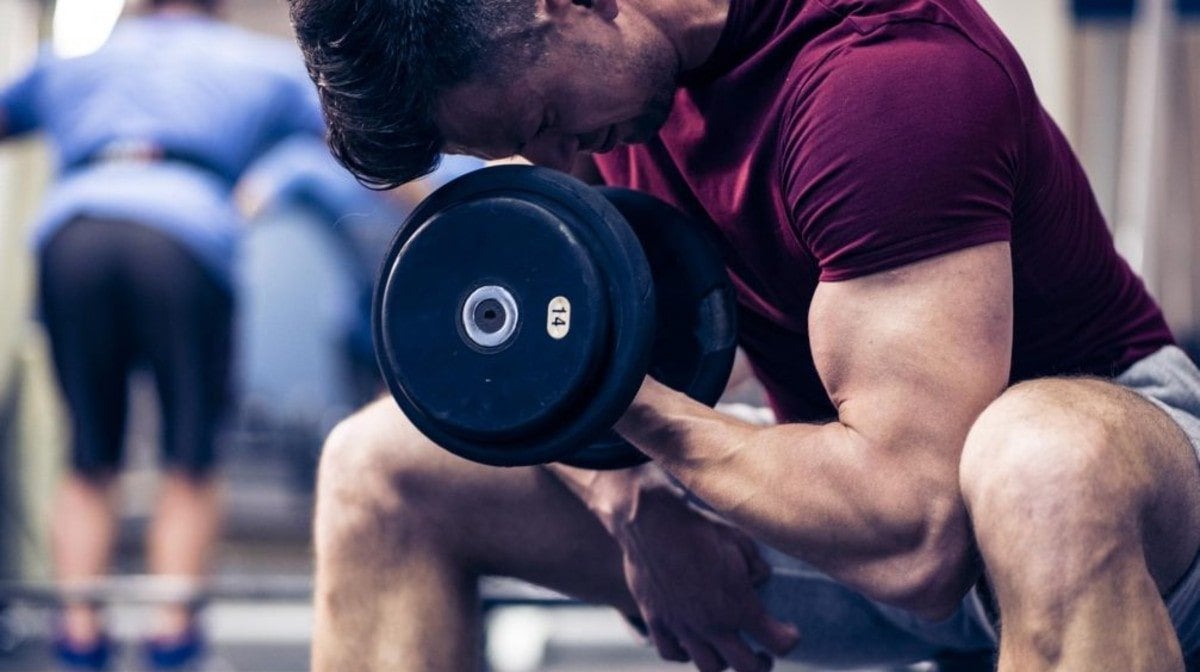How To Get Bigger Biceps | 7 Easy Steps

If you want to grow big biceps, you’ll need to be disciplined and follow a structured and progressive routine if you want to have any success. Big biceps are desired by many, but achieved by few, often due to the neglection of basic core training principles. This article will guide you on the path to filling out your t-shirts more and set you in the right direction to make all the right decisions for yourself along the way!
1. Don’t Lift Too Heavy
Lifting too heavy may result in you performing ‘cheat curls’ – using momentum to shift the load, instead of your muscles. Even if the weights are lifted correctly, then you may be limiting the amount of reps you can perform. Generally, research agrees that 8-12 repetitions with a moderate load is best for inducing a hypertrophic response. While you will still make strength gains with heavier loads and lower reps, you will be minimising the potential for gains in muscle size. Ideally, you will feel fatigue (or ‘the burn’) when performing 8-12 reps with a moderate load, with around 2-4 reps left in the tank (not every set or session has to go to failure!).
2. Focus On Technique
Disregarding technique when trying to isolate specific muscles (like the Biceps Brachii) will result in you not loading the muscles properly during the exercise, and thus not causing as much damage to the individual fibres. Faults like swinging during standing bicep curls will rely on momentum, instead of force produced by the muscle, to shift the weight. Neglecting technique may also increase your risk of injury as the weights being lifted are not being safely controlled. Sacrificing the amount of load/reps performed in order to progress safely will ultimately be in the best interests of your long-term gains.
3. Slow It Down
Otherwise referred to as increasing time under tension, the eccentric (lowering) phase of the exercise is acknowledged to be the phase which causes the most damage (or microtears) in the muscle fibres. Facilitating more exercise-induced muscle damage means that you can make the most of your recovery – as there will be a greater volume of new muscle tissue added during the repairing of damaged fibres.
4. Work From Different Angles
The biceps crosses both the elbow and the shoulder joints, thus in order to maximise the effects of hypertrophy, you should be trying to work the muscles throughout the range of motion available to the elbow and shoulder, thus allowing the biceps to work at different lengths. The biceps are responsible for elbow flexion/supination and shoulder flexion, and other muscles act as accessories (known as synergists) to the prime mover in these movements – and thus contribute to the muscle mass in the region. With the exercises listed below, you will be given the tools to effectively load all these muscles through their full range of movement and therefore experience the most hypertrophy possible.
5. Don’t Neglect Recovery
Recovery is arguably the most important part of the process, which is most often neglected by all levels of lifters. Many see the merits of going hard in the gym but proceed to not eat enough protein and get fewer than 8 hours of quality sleep per night. In order to maximise the effects of the work you apply in the gym, you should be shooting for around 8 hours of sleep per night (best facilitated with a very dark, silent and cool room), between 1.8g and 2.2g of protein daily and aim to minimise psychological stress in your day to day life. Since your body sees gaining muscle as a luxury (beyond sustaining basic needs for survival), you will need to be in at least a moderate calorie surplus (including the aforementioned protein guidelines!) to gain muscle.
6. Don’t Over-Train (But Don’t Under-Train!)
Many people assume the secret to big muscles is to be lifting 24/7. Following the last point about ensuring your recovery is sufficient, you should avoid training the same muscle group too frequently each week (think of indirect loading too – e.g. exercises like pull-ups or rowing movements will also load the biceps).
Your Maximal Recoverable Volume (or MRV) should be considered – this is the maximum amount of volume that you can perform which you are still able to recover from effectively prior to the next session. All training of the same muscle group beyond this point becomes redundant, as you are unable to recover and get stronger as a result of it. Likewise, Minimum Effective Volume (or MEV) is the minimum amount of work that it will take you to see adaptations from. Ideally, instead of ruining yourself every session, you should aim to be close to, but above your MEV. This is because, once you introduce more training load/volume, your MEV rises – meaning you will constantly have to do more work than before to see gains. Working close to your MEV means that you will be able to make consistent gains over a long period of time.
7. Vary The Stimulus
As with any exercise, your body adapts to the stimulus that you present it with. While you won’t be able to ‘confuse’ your muscles, introducing new stimulus is a tried and tested way to ensure that your muscles are forced to continue developing and adapting to new challenges. The stimulus comes in the form of volume, intensity, frequency and exercise type. Over the course of 8-12 weeks, the number of times per week that you train your biceps, the volume and intensity (load) and the exercises that you perform should all vary somewhat.
For instance, week 1 might see you perform 3 sets of 8 with 10kg dumbbells, performing hammer curls twice per week, increasing one of the variables (sets, reps, load or frequency) each week, and introducing different exercises as the weeks go on. This will is otherwise known as progressive overload, which is an essential concept behind muscle hypertrophy and increasing your strength.
Best Exercises for Building Bigger Biceps
This list of exercises is not exhaustive of everything that you can do to train your biceps, however, it provides a very solid base which will allow you to progress for a long time. Bodyweight exercises, resistance bands, dumbbells, barbell and cables are all included in this list, so hopefully, you will be able to execute at least a few of these, regardless of the situation with gyms in the near future!
1. Chin Ups
- Grip the bar with your palms facing towards yourself, about shoulder-width apart
- Pull yourself up until your eyes are above the bar height
- Slowly lower yourself down until your arms are fully extended before repeating
Tip: Keep your elbows close and squeeze at the top. You should feel this in your lats, biceps and your upper back.
2. Bodyweight Incline Curls
- Find somewhere that you can hold onto whilst you are on an incline with your back facing the ground (i.e. wrap a towel around a secure place and lean back with your arms extended)
- Performa bicep curl by pulling your hands towards your face
- Slowly lower yourself before returning to the start position
Tip: If doing this at home, experiment to find the best set up. If you are doing it in the gym, simply set up a barbell in the rack at an appropriate height.
3. Resistance Band Supinated Curls
- Secure a resistance band to the ground by standing on it
- There should be a small amount of tension on the band whilst your arms are holding it relaxed by your sides
- With your palms facing forwards, and your elbows tucked at your sides, curl the band up until your elbow are fully flexed, then slowly lower and repeat
4. Resistance Band Hammer Curls
- Secure the band to the ground (i.e. stand on the end of it) and hold the band with a neutral grip at your hips (there should be a slight amount of tension on the band at this point)
- Flex at your elbows until you reach the end of your ROM
- Squeeze at the top before returning to the start position in a controlled manner
Tip: Be sure to make the band short enough that it has a reasonable amount of tension/resistance for you to perform the exercise and fatigue the biceps
5. Supinated Barbell Bicep Curls
- Hold the barbell with your arms relaxed and palms facing forwards (underhand grip)
- Flex at the elbow until you reach the end of your ROM
- Slowly return to the start with your arms fully extended before the next rep
Tip: ‘Bend the bar’ by supinating your forearms hard against the bar (biceps muscle also supinates the forearm, thus this will elicit greater activation throughout the exercise).
6. Pronated Barbell Bicep Curls
- Hold the barbell with your palms facing yourself/the floor (overhand grip)
- Flex at the elbow until you reach the end of your ROM
- Squeeze at the top before returning to the start position
Tip: Use a comfortable grip (around shoulder width) to avoid putting unnecessary strain on your wrists.
7. Dumbbell Hammer Curls
- Using dumbbells, start by holding them at your side with relaxed arms and a neutral grip (palms face your hips)
- Flex at the elbow until you reach the end of your ROM, squeezing at the top before you slowly return to the start position
Tip: Avoid cheat reps by swinging – this may indicate the weight being used is too heavy and should be reduced in favour of perfect rep execution.
8. High Pulley Cable Curls
- Using a cable machine, set the pulley to around eye level
- Stand away from the machine so that your arm is fully extended (hand at shoulder height) with slight tension on the cable
- Flex at the elbow until you reach the end of your ROM, then squeeze before slowly returning to the start position
Tip: This can be performed with the arm abducted to the side, or with the shoulder flexed straight ahead.
9. Shoulder Extended Cable Curls
- Start holding the cable with your arm extended with the cable held behind yourself (i.e. shoulder extended)
- Curl the weight until your elbow is fully flexed, whilst tucked at your side
- Squeeze at the top before slowly returning to the start position
10. Incline Bench Curls
- Set the bench to an incline and allow your arms to hang straight down whilst holding dumbbells
- Flex at the elbow until you reach the top of the rep
- Squeeze at the top of the rep before lowering to the start in a controlled manner
Tip: Use dumbbells for this exercise. You can perform supinated, neutral (hammer) or pronated curls, thus targeting different prime movers.
11. Preacher Curls
- Using a preacher curl rack or an inclined bench/surface, support the back of your upper arm
- Start with your arm relaxed/extended
- Flex at the elbow until you reach the end of your ROM, then slowly return to the start position
Tip: Use a lighter load than usual for this, as it is much more difficult for the synergist muscles to contribute to this lift.
12. Spider Curls
- Ideally, using an incline bench, stand with your torso prone on the bench
- Your arms should hang towards the floor whilst you hold the selected load
- Flex only at your elbows, until you reach the top of the rep
Tip: Squeeze at the top of the rep to elicit the most activation from the muscle, before slowly returning to the start position.
13. 21’s (Method)
- Using a barbell or dumbbells, this exercise can be performed using any of the other exercises described
- Perform 7 half reps from the bottom to midway, then 7 reps from midway to the top, then 7 reps using full ROM
- Maintain proper technique throughout
Tip: You can alter the number of reps for this, and simply split the reps into 3 segments as described.
14. Zottman Curls
- Using dumbbells, perform a supinated bicep curl
- Pronate your hands at the top of the rep (so your hands are now facing down)
- Slowly lower to the start position, and start the next rep back in the supinated position
Tip: Ensure you maintain control and proper form throughout the exercise.
15. Pyramids (Method)
- This can involve any of the other exercises of your choice
- Start with a low load (e.g. 8kg), perform a set number of reps, then move up by a few kg. Repeat this until you hit a peak weight, then go back down in weight. (i.e. 4 reps at each load – 8kg, 10kg, 12kg, 14kg, 12kg, 10kg, 8kg).
- Alternatively, drop the number of reps as you increase the load, then increase the reps as you drop the
Tip: This is a good way of accruing volume in a working set. Aim to maintain perfect form for every rep.
16. EZ Bar Curls
- Start with holding the bar with your arms extended/relaxed
- Curl the bar up until your elbows are fully flexed
- Lower the load in a slow and controlled manner before starting the next rep
Tip: Use a moderate load which allows you to execute each rep with perfect technique, whilst still facilitating fatigue towards the end of each set. Avoid any swinging during each rep – this would suggest that the weight is too heavy.




